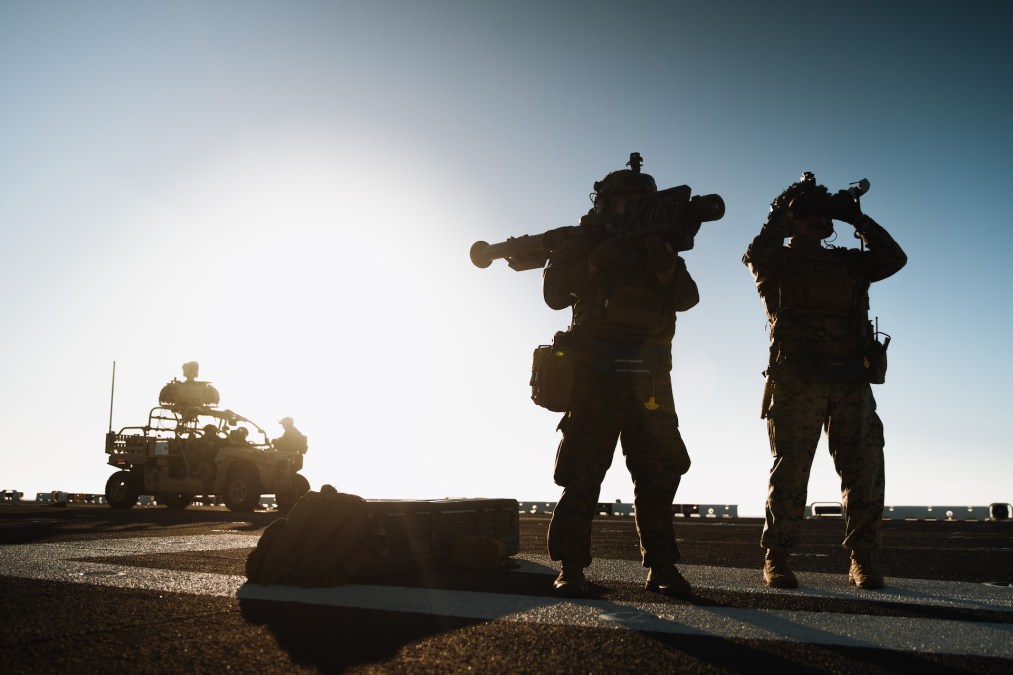New Marine Corps ‘fusion center’ to focus on counter-drone tech

The Marines recently set up what they’re calling a “fusion center” at their base in Quantico, Virginia, and its first order of business will be to focus on counter-unmanned aerial systems capabilities.
The office, which was stood up in the past few months with little fanfare, is designed to bring together officials from various organizations that play a key role in Marine Corps modernization to help move capabilities from the science-and-technology enterprise through the acquisition pipeline to fielding.
“The key is geography matters. We can sit there and go, ‘What does S&T have in the future for us?’ And we look at that and say, ‘OK, this is what’s in the realm of the possible.’ And then … we can say, ‘OK, how much overlap do we have in some of these capabilities?’ And so with a limited number of resources, it helps us to figure out which are the ones that we need to go after that are going to fill our gaps to the greatest capability,” Brig. Gen. Stephen Lightfoot, director of the Marine Corps Capabilities Development Directorate, said during a panel Tuesday at the Modern Day Marine conference.
Steve Bowdren, head of the service’s program executive office for land systems, said the fusion center will help his program managers “look left” for new opportunities.
“For me and for my programs, they’re laser-focused on cost, schedule, performance — with schedule being the driving factor. But we’ve got to make an investment in looking left, program managers look left and see what’s in the S&T pipeline, what’s in the R&D pipeline, so that as we’re delivering and getting feedback on our deliveries and our fielding, we have an understanding of what technology is not far away that we can pull into that next engineering change proposal we make,” Bowdren said.
“Some things we’ll be able to pull into an emerging program of record. And there’ll be some things that I’m hoping we can facilitate into our immediate program of records as a kind of engineering change proposal technology refresh out there … even potentially with software as we’re fielding. So I’m gonna look forward to that. We’re really focusing our program managers on again, you know, the constant looking ahead at their planning and their milestones. But look to the left occasionally. And with this fusion cell, we have resources there to help that,” he added.
The new fusion framework will initially focus on counter-drone capabilities, according to Kevin Murray, chief technology officer at Headquarters Marine Corps.
Brig. Gen. David Walsh, commanding general of Marine Corps Systems Command, said the fusion center was stood up “in the last couple of months.”
“We didn’t really have like a ribbon-cutting ceremony,” he told reporters on the sidelines of the conference. “They’ve been kinda like falling in and building on the fusion center over the last several months.”
The push for new tools to counter unmanned aerial systems comes as U.S. troops and others have been under assault from one-way attack drones in the Middle East region, and officials are seeing UAS play a prominent role in the Ukraine-Russia war in Europe.
“When you look at what’s going on in Ukraine and Russia and just the amount of small UAS first-person-view drones. And then looking at some of the commercial off-the-shelf technology, like cellphones that are being used to cue, using audio to be able to cue to come in. And there’s a lot of counter-to-counters going on over there. And the longer it takes us to get to it … we’re going to get farther and farther behind,” Lightfoot told reporters.
“We know that that is a big, big part of the future,” he added. “If there’s any part of … I would say changing character of war, small UAS and counter UAS are probably the biggest change that we’re seeing.”
Bowdren noted that the Corps is set to ramp up its counter-drone arsenal. The service previously had limited tools at its disposal for these types of mission sets.
“Five years ago, the Marine Corps really just had Stinger [man-portable air defense systems]. That was it. Now, we’re on the cusp of deploying a whole suite of systems to counter UAS in a way that can be rapidly upgraded … to accommodate the new threats,” he told reporters.
That includes a vehicle-mounted Light Marine Air Defense Integrated System (LMADIS), which the service has been working on under a joint urgent needs program.
“We’re building a program of record for that. We’re going to be going into testing this year on that and looking for fielding next year,” Bowdren said.
The Corps has also been pursuing a system that Bowdren described as “big brother” MADIS, which is slated to undergo initial operational test and evaluation in the next couple of months. Officials are aiming to field it in the next fiscal year.
“And then building on top of that, we’ve got the Medium-Range Intercept Capability, which can defeat UAS up to Group 3, and then beyond with the counter cruise missiles and other things. So that is going to be operationally assessed this year and [we’re] looking forward to a potential deployment within a year from now,” he said.
Additionally, officials are going after tech to protect military installations from small drones.
“We have some … urgent need systems out there today. But we’re building a program of record, which we’ll be deploying within the next year if we get all the bids straightened out and award a contract on time,” Bowdren said.



